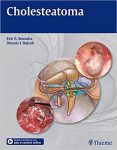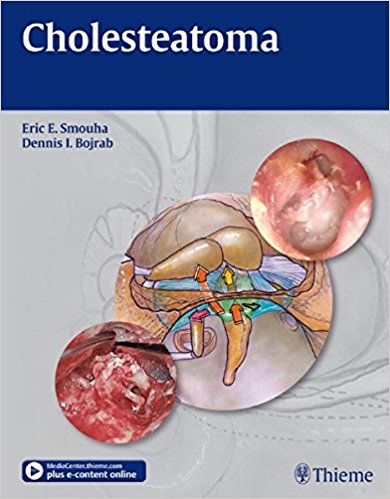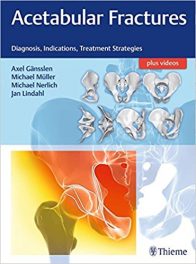 Authors: Eric E. Smouha, MD; and Dennis I. Bojrab, MD
Authors: Eric E. Smouha, MD; and Dennis I. Bojrab, MD
Publisher: Thieme – 157 pages, with 280+ illustrations
Book Review by: Nano Khilnani
Cholesteatoma is a growth of keratinizing squamous epithelium. It originates from the external layer of the ear canal (tympanic membrane). When viewed in a photo shown on the bottom right of page 1, it is a white substance that invades the middle ear cleft (the air-conditioning space that is medial to the plane of the tympanic membrane.
The authors write in the first chapter entitled General Considerations in Cholesteatoma that this disease would have been better named keratoma. Cholesteatoma has two components:
- The acellular keratin debris which forms the contents of the sac
- The matrix which forms the sac itself
The cholesteatoma matrix consists of an inner layer of keratinizing squamous epithelium and an outer layer of sub-epithelial connective tissue (perimatrix).
Of the two components, the matrix is the biologically active one in cholesteatoma. The epithelial layer produces the keratin, whereas the sub-epithelial layer contains mesenchymal cells that can resorb bone and that give cholesteatoma its invasive properties.
Cholesteatoma is a destructive process. It invades the middle ear and causes damage with passive growth and active destruction of adjacent bony structures essential to hearing.
This is a rare book on a disease that most people have likely not heard about. We strive to review in our Books section, literature on rare medical topics, and this is one such example. This book contains 12 chapters that we list below to provide you a broad overview of its contents:
- General Considerations in Cholesteatoma
- Tympanoplasty: Indications and Technique
- Ossicular Chain Reconstruction
- Mastoidectomy
- The Meatus and Cavity Management
- Situations that Arise at Surgery: Anatomical Issues
- Situations that Arise at Surgery: Hearing Issues
- Controversies in Cholesteatoma Surgery
- Congenital Cholesteatoma
- Recidivism
- Complications of the Disease4\
- Complications of the Surgery
Find surgical videos for Cholesteatoma online at www.MediaCenter.Thime.com.
When prompted during the registration process, scratch off the gray film on the first page of this book, and enter the code provided therein.
The chapters of this book have ample and well-organized content including full-color graphics, and we provide you below an outline of the topics covered in its first chapter, so that you can get an idea of the organizational system of topic presentation in the chapters throughout the book.
- Chapter title: General Considerations in Cholesteatoma
- Twenty-five photos are presented with detailed captions in pages 1 to 9
- Perioperative Assessment
- Physical Examination and Microscopy
- The Role of Imaging
- The Wet Ear
- Preoperative Counseling
- Expected Results: Risks, Benefits, and Alternatives
- Risk of Recurrence
- Need for Additional Surgery
- Postoperative Care
- References: 17 sources of information are provided
Among the important features of this book are:
- Online access to surgical videos performed and narrated by the authors
- More than 280 vibrant full-color images that demonstrate the different progressions of disease, not shown in other texts
- Insightful chapters cover recidivism and complications both of the disease and surgery while operating room cases illustrate surgical approaches
This book is useful for otolaryngologists – head and neck surgeons, residents, and fellows. They can go online to refer to the most up-to-date information on cholesteatomas and other middle-ear lesions.
It presents the three components of middle-ear surgery: the middle ear, the mastoid, and the meatus and resultant cavity. The authors provide perspectives on the controversies in cholesteatoma management like canal wall reconstruction, facial nerve monitoring, the use of endoscopes in chronic ear surgery, and postoperative care.
This is an excellent text on the rare and destructive disease of cholesteatoma, with lots of images, diagnostic methods, and detailed operative procedures.
Authors:
Eric E. Smouha, MD is Associate Professor in the Department of Otolaryngology at Mount Sinai School of Medicine, and Director of Otology and Neurotology at Mount Sinai Medical Center in New York, New York.
Dennis I. Bojrab, MD is CEO and Director of Research at Michigan Ear Institute, and Professor and Chairman of Otolaryngology at Oakland University Beaumont School of Medicine in Royal Oak, Michigan.
He is also Clinical Professor of Otolaryngology and Neurosurgery at Wayne State University School of Medicine in Detroit, Michigan; Co-Director of St. John Providence Health System in Novi, Michigan; and Founding President of American CISEPO (Canada International Exchange Program) in Farmington Hills, Michigan.







